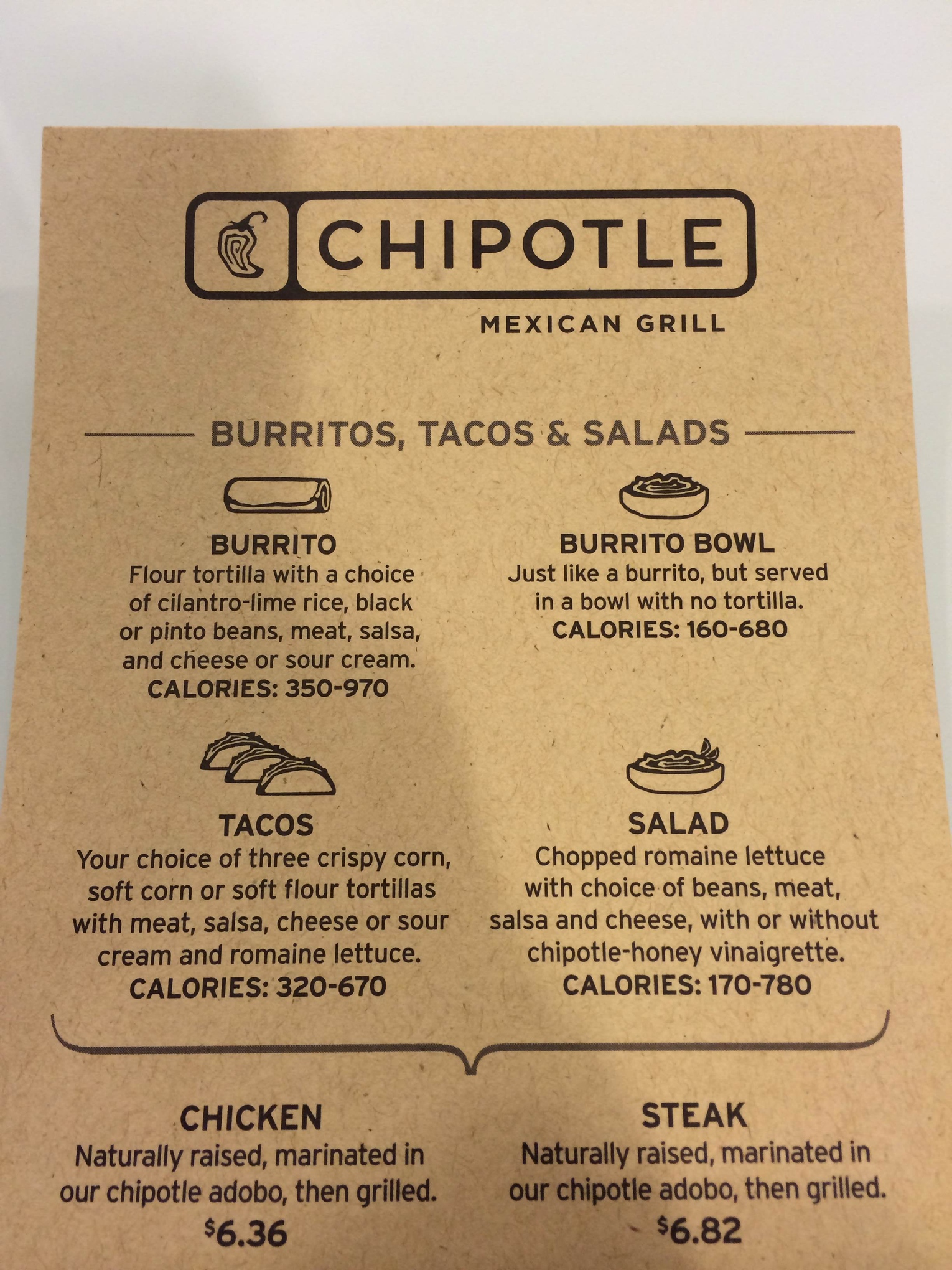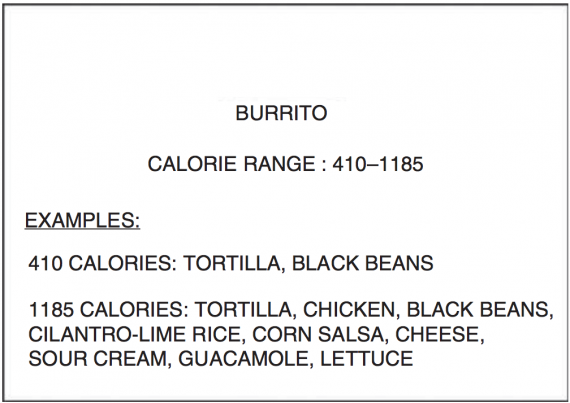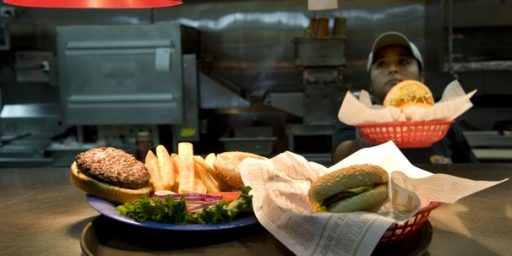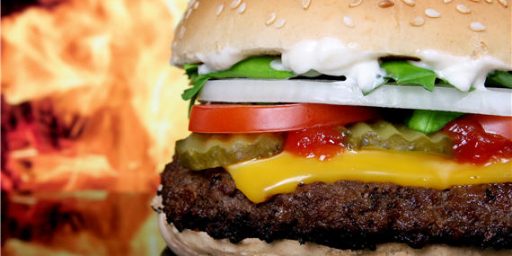Don’t Blame Chipotle for Useless Calorie Information
Vox is mad at Chipotle for doing what the law requires.
Sarah Kliff wants you to know that “Chipotle’s calorie labels are a lie.”
The ranges on menu items are so vast that, depending on what your order looks like, a burrito could have 350 or 970 calories – nearly a threefold difference. (Never mind that it is nearly impossible to order the lowest-calorie Chipotle burrito, which consists of a flour tortilla with beans.)
This is a problem that lots of fast food chains are confronting now that the health care law requires them to post calorie counts on their menus. At establishments where menu items are highly customizable, places like Chipotle or Dominos, coming up with accurate calorie counts is a vexingly difficult tax.
Chipotle has settled on providing consumers with a calorie range that is, well, quite large. And when consumers see that range, a new study in the Journal of Public Health Nutrition finds, they underestimate the calories in their own burrito by 21 percent.
But why is that Chipotle’s fault? All they do is cook the food and spoon in the stuff that customers ask for.
Kliff tells us that the study found that people do better with a menu that looks like this:
Well, okay. But there are manifold problems with that menu.
First, it’s ugly as hell.
Second, it’s much less compact. That’s rather important since the procedure at places like Chipotle is for people to stand in a line and place their order for a category item (say, a burrito bowl) and then go down the line and tell people which things they want on it. The process would grind to a halt if everyone had to stand around deciphering the menus and weighing the calorie choices of individual ingredients. Most people are still going to order the stuff they like on their burritos but some significant number would now be primed to start asking questions about the calorie count of the guacamole. Normal customers who just want a damn burrito quickly so they can get back to work would get frustrated and quit coming back.
Third, it’s still not particularly useful. I’m guessing the lettuce isn’t adding much to the calorie count of the second burrito. Ditto the corn salsa.
Fourth, as Kliff admits, Chipotle’s menu is actually more compliant with the law than her proposed version:
The Obamacare requirement to post calorie labels, however, favors the range approach. In regulations published in 2011, the Food and Drug Administration directed restaurants to publish a range from the lowest calorie version of an item to the highest. But it doesn’t say anything about including examples of what’s included at each end.
“Critics of calorie-count regulations are correct to point out that we cannot justify the costs of such requirements if the mandated information does not improve consumer understanding,” study co-authors Peter Ubel and Peggy Liu write at the Monkey Cage Blog. “The FDA should require restaurants to define the endpoints of calorie ranges. Consumers deserve comprehensible information about their food choices.”
I don’t have any heartburn with that. I’ve got a pretty good idea that cheese, sour cream, and guacamole are high in fat and calories, although there’s still substantial variation within those items. Lean beef and chicken should be relatively low in calories but I haven’t the foggiest what “chipotle adobo” marinade does to the equation. And the cilantro-lime rice is the real wild card; adding a sauce to rice could wildly change the calorie hit.
It strikes me that the fix is actually fairly elegant: Chipotle should leave their menus as is and then add a single “calories by ingredient” list at the bottom. Or, better yet, post the calorie count of individual fixin’s right there on the little signs that label said fixin’s along the assembly line.







Yet another example of Government run amok.
I’m a little surprised they don’t do that.
Ah, but the people standing in line waiting for a burrito could get the menu and decipher the caloric information before getting to order. It’s just a matter of putting the basket full of menus near where the line starts.
Mind you, this won’t work with fast food chains where the menu is literally hanging above the workers and doesn’t have the space for it.
@Eric Florack: No no, government run amok would be if they mandated we had to eat lettuce.
@Tillman:
Pretty much. Florack is of the nature that a red light or a public library is “yet another example of government run amok.”
__________________________________
As for the calorie count stuff, I think the ranges are more useful than nothing, but I’m not the intended audience for a calorie count. It takes me almost no effort to ignore them completely. Put them on the menu and I’ll just get accustomed to not looking at them.
The problem isn’t that there’s no valuable information being conveyed with these ranges. The problem is that people are not always capable of ingesting valuable information. Kliff seems to acknowledges that:
Yes, it’s true. Some people are unbelievably stupid.
You’re not going to help them with more detailed calorie count information.
The survey cited sampled everybody exiting the Chipotle. The point to calorie labeling is to make the information available to those who want it. The guy in front of you in line who put some of everything on until the poor girl had to pound on it to get the tortilla around it didn’t know or care how many calories he’d eaten until the guy with the clipboard asked. Had they qualified respondents by asking if they were counting calories or trying to watch their diet, I suspect they would have gotten much better results.
James’ point seems to be that Sarah Kliff is being something of an a** with her clickbait title. True. I have no idea what @Eric Florack:’s point is supposed to be. The tyranny of forcing Chipotle to spend not much money providing imprecise information? The horror.
There’s little evidence that calorie count mandates do any good. Penn and Teller did an episode on this where they showed that people have a pretty good idea how bad fast food is for them and are usually pretty accurate in guessing the calories. The real surprise is that when they are in fancier restaurants, they *severely* underestimate the calories they are getting. In fact, in the experiment they showed, people were given the same Taco Bell taco salad. When they were told it came from Taco Bell, they guessed the calorie content pretty accurately. When they were told it came from a locavore organic authentic taco shop, they guessed it had half the calories it actually did.
Some of the local fast-food restaurants here are getting pretty good at putting a calorie-counter thingie on line. Just click all the radio buttons of the options you’ve chosen, and it spits out a calorie count.
There is a very simply solution for this. Develop an app that lets a customer build the burrito they like on their smartphone. Presto, you have an accurate calorie count. Too high? Subtract a few items till you reach your calorie goal.
This would allow customers to get accurate calorie information on the fly. The online country grumpy realist mentions is good too, but an app works much better when you are in the store. For Chiapolte, (or any other vendor) it has the added benefit of giving them a dedicated presence on a customers phone, which is a win all by itself.
Mandatory calorie counts a good thing for consumers. Implementation is the key to success.
BS. There are a lot of things I’ve stopped getting when I saw what calorie bombs they are.
@Eric Florack:
I’ll take your comment seriously if you agree that the War on Drugs is another, bigger example. If you think the War on Drugs is fine, but think asking for info on calorie restrictions is too much gov’t, then you’re too hypocritical to bother taking seriously.
@anjin-san: I’ve done that too, specifically with a shake at McDonald’s that looked so good on the poster outside but when I found out it had 1100 calories I just couldn’t bring myself to order it. I appreciate my out of control government making them tell me the calorie counts – if you don’t want to use them, don’t.
Three points:
(1) What’s wrong with having that calorie information? Nothing.
(2) Do people bitch and moan about labeling of the food they buy at the market? Only insofar as they able to read (or not read) the labels.
(3) As for the menu aesthetics, I think that Chipotle marketing and management staff can figure out how to manage that.
Putting the Fooducate App on your smartphone will solve that problem.
@Hal_10000:
For some it does, for others it doesn’t.
What actually works is telling people how long they would have to exercise to burn off all the calories…
I’ve encountered a few restaurants with calorie ranges like that, and I’m always annoyed at them. I make the assumption that mine would be at the top of the range, but as you say James, it would be so much easier if they gave a calorie by ingredient list so I could determine if the guacamole is worth the extra calories or if I really ought to skip it.
Actually, I do blame Chipotle. It took me about 90 seconds to come up with a method to address the problem. We are not talking about unlocking the secrets of the universe here.
@anjin-san:
Except Chipotle’s website has a nice app that let’s you configure a meal and determine the nutritional properties. I switched from burritos to bowls due to calories, cut out sour cream due to calories and saturated fat, and kept guacamole because of good unsaturated fat. The only negative property was the sodium, the negative effects of which are probably overblown.
@ Chipotle Man
An app is software, generally with a fairly narrow focus, that runs locally on a mobile device. What you are describing is website functionality, which is something different, though it might do the some of the same things an app does.
The advantage of an app for Chipolte is that it is very easy to run on a phone while one stands in line, as opposed to trying to use a website on a phone, which can be problematic.
An app is also a very useful marketing tool, Chipolte could use it to push online coupons and other information to the user and also take advantage of the phones location feature.
Good for Chipolte for having a calorie tool on their website. That being said, the menu shown in the post is very poorly done, and they should do more for their customers that are actually in the store.
@Tillman: Both are true.